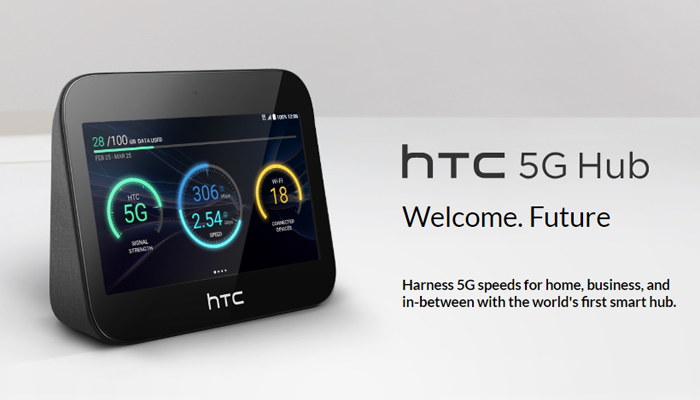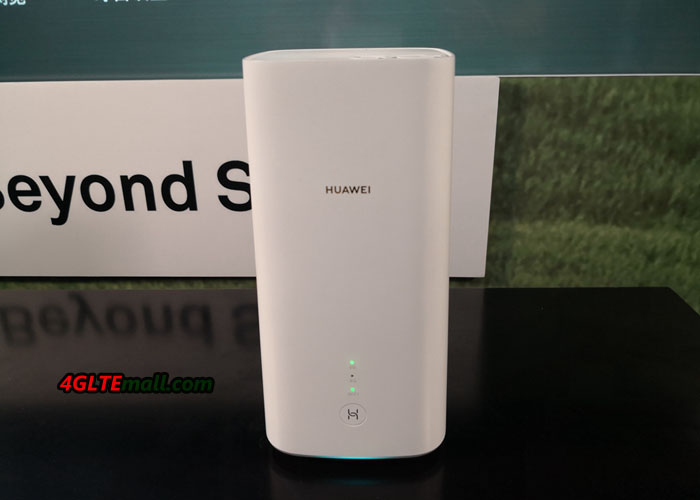HTC was one of the first manufacturers to introduce a 5G hub at MWC 2019, which was launched in the second quarter of 2019. It uses the new 5G mobile communication standard for fast data transmission and is primarily suitable for home use, but can also be used on the go. One of the main features on the front of the device is a large display. In addition, the HTC 5G hub will later support a cloud VR mode, in which a local player can be omitted.
HTC 5G Hub Specs and Features |
|
| Manufacturer and device name | HTC 5G hub |
| Supported mobile standards | 4G, 5G |
| 5G network modes | Non standalone(NSA) |
| chipset | Qualcomm Snapdragon 855 Octa-Core with Snapdragon X50 5G modem |
| Maximum 5G data rate | 2.63Gbps Down & 287Mbps Up |
| LTE frequencies | Bands 2, 3, 4, 5, 7, 8, 12, 13, 25, 26, 66, 71 |
| mmWave frequencies | between 26 and 28 GHz |
| Sub 6 GHz frequencies | Yes, 5G bands n41, n78 |
| 5G external antenna can be connected | No |
Network Feature (LAN & WiFi) |
|
| WLAN standards | 802.11 a/b/g/n/ac/ax |
| Maximum gross data rate with WLAN | HTC did not provide any information |
| Supported WLAN bands | 2.4GHz, 5GHz and 60 GHz |
| WLAN guest access can be installed | ? |
| WLAN encryption standards | WPA, WPA2, WPS |
| Gigabit LAN | yes, 1 port Gigabit Ethernet |
| WAN port | No |
Telephone |
|
| Telephone function | No |
Display |
|
| Size & resolution | 5 inches, HD (720 x 1280 pixels) |
| Touch capable | Yes |
Other features |
|
| IPv6 support; Dual stack | ?? |
| suitable for IPTV | Yes |
| Can be used as a media server | yes (microSD up to 512 GB) |
| USB ports on the back | No |
| Battery for self-sufficient operation | yes (7,660 mAh) |
| Dimension and weight | 129mm x 100mm x 43mm at 340g |
More information |
|
| Datasheet for download (PDF) | ” not yet available |
| Manual for download (PDF) | » Available at HTC official site |
| Available at | » https://www.4gltemall.com/ |
High data transfer rates
Inside the HTC 5G Hub is a Snapdragon 855 Octa-core chipset, a CPU with Octa-core, which is installed in the latest 5G smartphones like the ZTE Axon 10 PRO 5G phone. With the Snapdragon X50 5G modem, the HTC 5G router supports maximum data transfer rates of 2.63 Gbps in the download and up to 287 Mbps in the upload. If no 5G connection prevails, the device can also switch to and work on 4G network. A fallback to older technology such as 3G or 2G can’t be done in the HTC 5G Hub.
Nevertheless, a mobile application is possible. In addition to power from a power outlet, the HTC 5G Hub also has a built-in battery. The capacity of 7,260 mAh should provide enough energy for a whole day. The battery is charged either with the enclosed power supply, via USB Power Delivery on the 9 Volt rail or with Quick Charge 3.0 via USB.
WLAN for up to 20 devices
If the HTC 5G Hub has established a connection to the 5G network, it distributes the signal via WLAN in its environment. Not only the usual IEEE 802.11a/b/g/n/ac standards are used, but also 802.11ax (WiFi 6). This means that the HTC 5G Hub can span not only the familiar 2.4 and 5 GHz frequencies but also a 60 GHz WLAN. However, only a few devices support this new standard so far. Wifi at 60 GHz has very high data transfer rates between the 5G WLAN router and the terminal, provided that there are no obstacles such as walls in the way.
However, the number of maximum connector users is limited. A maximum of 20 clients can connect to the HTC 5G Hub via Wi-Fi. There are four high-speed connections via 802.11ax. This limit can be quickly exceeded today in a household with various technical devices. Other Wifi access points usually support more connections, ie 32 to 64.
Integrated display and speakers
Visually, the HTC 5G Hub is more like a Google smart home hub rather than a traditional router. This is mainly due to the integrated touchscreen on the front of the device. This measures 5 inches and displays the contents in HD resolution with 720 x 1,280 pixels. In addition, two speakers for stereo sound and a microphone that pays constant attention to voice commands, are integrated.
The HTC 5G Hub is in the dimensions of 12.9 x 10 x 4.3 cm and weights 340 g and provides 4 GB of RAM and 32 GB of memory. If the internal memory space is insufficient, it can be expanded via microSD card. What exciting are the possibilities that the HTC 5G Hub can stream content to other devices such as a TV and the use of Cloud VR is also planned. A local player can then be omitted in the presentation of VR content. Instead, the data is streamed via cloud computing. This is made possible by the potentially low latencies of 5G. This requires a compatible 5G network that allows mobile edge computing.
Price and availability
The HTC 5G Hub is available for many network providers over the world. Together with the Tariff, you may get cheaper price. If you only get the single HTC 5G Hub, the price would be much higher.


















